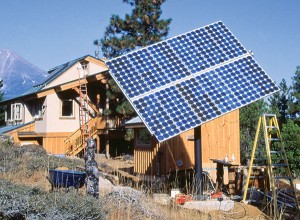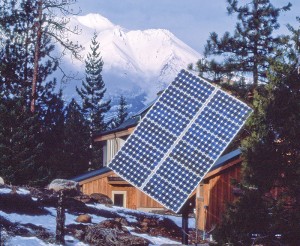By Kristen Stroud. Published in Northstate Parent Magazine, March 2010 issue.
Download original article (PDF)
 Whatever your reasons or your budget, researching and investing in alternative or renewable energy sources such as wind, solar or hydroelectric can shift your perspective in new and exciting directions. If you are looking to reduce your dependence on non-renewable fossil fuels or want to invest in cost-saving, energy-efficient technology, you can find a wide variety of workable solutions to meet your needs.
Whatever your reasons or your budget, researching and investing in alternative or renewable energy sources such as wind, solar or hydroelectric can shift your perspective in new and exciting directions. If you are looking to reduce your dependence on non-renewable fossil fuels or want to invest in cost-saving, energy-efficient technology, you can find a wide variety of workable solutions to meet your needs.
You can transition your conversion to alternatives in manageable stages or make the shift all at once. Even if you don’t choose to install renewable energy technology such as solar electric or hot water panels, there are many affordable ways to make your home more energy efficient, including signing up for greener options offered by your power company. Since no power source is completely green, reducing energy demand, increasing energy conservation, and improving energy efficiency of existing homes and appliances ought to be the starting point for all projects.
If you are interested in adding renewable energy generation to an existing home, cabin, boat or camper, or are planning new construction, there are many factors to consider and many excellent sources (magazines, contractors, websites, college courses, etc.) for answering questions about how to incorporate alternative power into your plans. There is no right way, only what makes sense practically, financially and ethically, for each individual or family’s lifestyle.
Solar Options
1. Passive Solar
Passive solar architectural designs aim to maximize solar warming in the
colder winter months and reduce heat buildup in the summer. Orienting a building due south with sufficient roof overhangs permits solar gain when the sun is low in the winter sky, but not when the sun is high in the summer. Thermal mass, such as concrete slabs, air spaces or water tubes, absorb heat during the day then gradually release it after the sun goes down. Natural lighting is another healthy and energy-efficient benefit of passive solar design. Solar design features such as light wells, sunrooms or greenhouses can be added to existing homes and buildings.
2. Solar Electric
Photovoltaic or PV solar electric panels form the decentralized home-based power generator for solar electric homes. Long-lived and extremely reliable, panels typically charge batteries during the day to store the power overnight. A computer-like device, known as an inverter, converts incoming electricity from the solar panels from DC to AC for powering normally-wired houses and appliances.
A solar electric home can operate completely free of the commercial power grid, or can be set up to intertie with the power grid through metering by the inverter. In California, several power companies have set up net metering programs to compensate homeowners for home-generated power flowing back into the power grid. (See the Northern California Solar Association and PG & E websites [below].)
Solar panels can be fixed, typically on a roof, or mounted on a tracker that “tracks” the sun’s movement throughout the day, increasing the efficiency of the panels significantly.
Solar installations require relatively unimpeded southern exposure to optimize electrical output—a solar contractor can evaluate potential sites for viability.
3. Solar Hot Water
Solar hot water panels heat water for household use or recreational uses such as swimming pools. Installation is usually straightforward, and the panels do not require much maintenance and are extremely cost-effective and energy saving over time.
Determine Your Energy Needs and Maximize Efficiency
Energy efficiency and conservation are the name of the game whether you are sucking juice from the power companies or harnessing it from the sun or wind. Personal and professional energy auditing can provide valuable information for improving the efficiency of insulation, heating, lighting and appliances to minimize energy waste. (See resource list on previous page.)
For example, many electrical items like clocks, radios, televisions, telephones and answering machines draw power even when the power button is turned off. To prevent these so called “phantom loads” from appliances that do not have built-in energy saving power switches, you can install a manual switch yourself. Paying attention to these details can save lots of energy over time. If you’re planning a remote, off-the-grid project, you’ll need to calculate your expected energy needs and use the most energy efficient appliances available. All of your energy needs can be accommodated if you plan for them.
If you are not a licensed electrician, you’ll want to find someone trustworthy to help you plan and execute your system. Local experts can walk you through the entire process, including: research, planning, system design, installation, grid-intertie, and future maintenance. Ask for references and talk with people who have already installed systems in their homes. (See Choosing Your RE Installer at the Home Power Magazine website listed in resource section.)
Financial Considerations
Most people want to know how much a renewable energy system will cost up front and how soon they will reach the break-even point on their investment (See Northern California Solar Association website [below].) This depends on the size and complexity of the system and whether you plan to operate your entire household on self-generated power or to supplement with grid power. Solar systems can be designed to increase power output incrementally.
In addition, you will want to factor in current federal, state, and local financial incentives and tax-credits that apply to your project. To learn more about the incentives you’re entitled to, visit the Department of Energy, Northern California Solar Energy Association, and PG & E websites listed [below].
ENERGY EFFICIENCY & SOLAR POWER INFORMATION SOURCES
- Database of State Incentives for Renewables & Efficiency; www.dsireusa.org.
- U.S. Department of Energy-Energy Efficiency & Renewable Energy; 1-800-363-3732; www.eere.energy.gov.
- Northern California Solar Energy Association (510) 705-8813; www.norcalsolar.org.
- PG & E California Solar Initiative (CSI)
Solar Hotline (415) 973-3480 (solar application related questions); Solar Customer Service Center 1-877-743-4112; www.pge.com/myhome/saveenergymoney/solarenergy.
Education & Training
- Butte College sustainability programs, Oroville; (530) 895-2511; www.butte.edu/sustainability.
- California State University, Chico, Institute for Sustainable Development; (530) 898-3333; www.csuchico.edu/sustainablefuture.
- Cleantech Innovation Center, Oroville; (530) 532-9770; www.cicoroville.org.
- College of the Siskiyous, Environmental Resources programs, Weed; (530) 938-5305; www.siskiyous.edu/cte/environmental.
- Shasta College sustainable development programs, Redding; (530) 242-7500; www.shastacollege.edu/cms.aspx?id=6821.
Books
- The Homeowners Handbook to Energy Efficiency: A Guide to Big and Small Improvements by John Krigger & Chris Dorsi, Saturn Resource Management, Helena, MT.
- Homeowners Guide to Building Performance: Comfort, Safety, Efficiency by John Krigger and Chris Dorsi, Saturn Resource Management, Helena, MT
- The Renewable Energy Handbook by William H. Kemp
Magazines & Websites
- Home Power: www.homepower.com.
- Home Energy: www.homeenergy.org.
- Green Building Advisor: www.greenbuildingadvisor.com.
Retailers/ Wholesalers
- Real Goods: 1-800-919-2400; www.realgoods.com
- Backwoods Solar Electric: (208) 263-4290; www.backwoodssolar.com
- Wholesale Solar, Mt.Shasta: 1-800-472-1142; www.wholesalesolar.com
Thirty years ago, writer Kristen Stroud studied alternative power and conducted energy audits as a college intern in the Berkshire Mountains of Massachusetts. She incorporated environmentally compatible design while earning a BS in Environmental Studies in the School of Landscape Architecture at the College of Environmental Science and Forestry in Syracuse, NY and moved into an off-the-grid, passive solar home with her husband in 1995. Their 14-yr-old son thinks the best thing about living off-the-grid is having no power bills, and their 11-yr-old son wishes the power would go out sometimes, just for the adventure of it.

